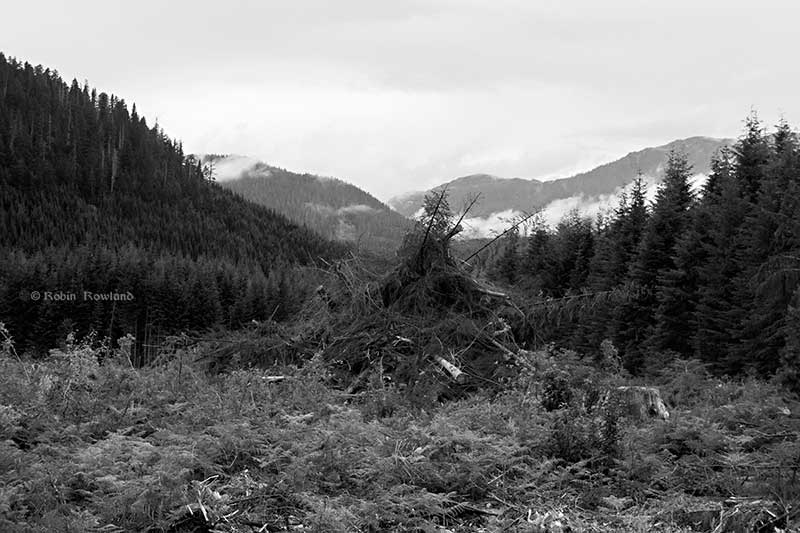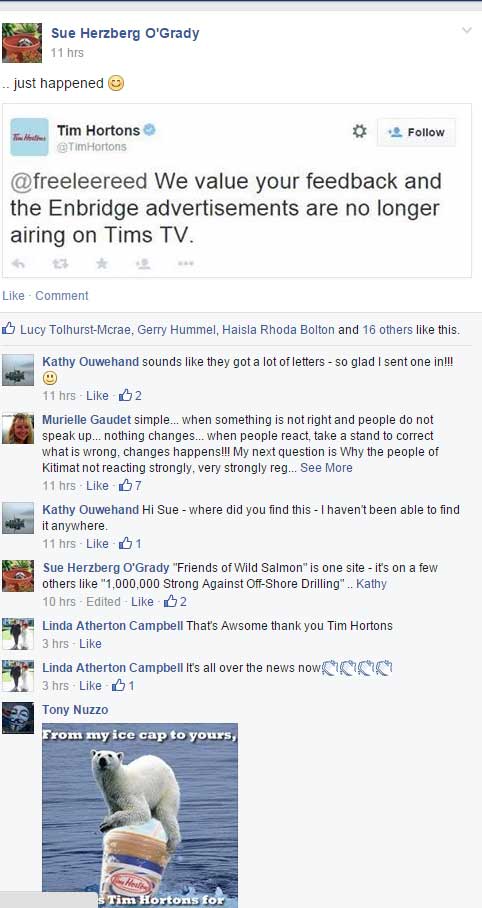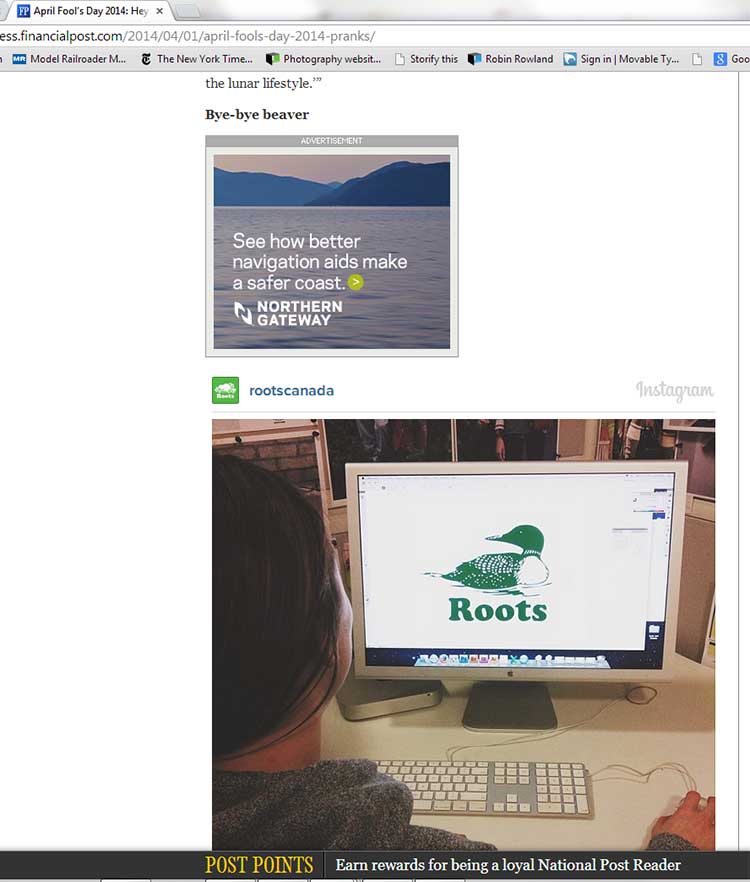A pile of slash at a quarry site for the Pacific Trail Pipeline near the Little Wedeene River. (Robin Rowland)
Category: News & media
Why the media coverage of the Tim Hortons boycott is a double double failure
The headline on Thursday’s CBC.ca coverage of the sudden controversy over a boycott in British Columbia of Tim Horton’s over the Enbridge ads sums up everything that’s wrong about media coverage not only of the boycotts, but of northwest energy and environment issues overall.
“Tim Hortons yanks Enbridge ads, sparks Alberta backlash.” The anger at Tim Hortons across northwest British Columbia over those Enbridge ads, the calls for a boycott have been building for more than two weeks but no one in the media noticed despite widespread posts on Facebook and other social media.
As usual, the concerns of the northwest didn’t really become a story until Alberta got involved and the story has become the “Alberta backlash.” Now, there’s a backlash on social media to the Alberta backlash, with northwestern British Columbians tweeting and posting their displeasure, angry at the usual blinkered views of Alberta-centric coverage of energy issues.
Let’s make one thing clear– despite the outraged cries of the usual suspects like Defence Minister Jason Kenney, Conservative MP Michelle Rempel, who represents Calgary Centre-North and Kyle Harrietha, the Liberal candidate for Fort McMurray-Cold Lake that the boycott was aimed at Alberta’s entire energy industry and the province’s views of a manifest destiny as an energy super power, the doughnut boycott was really aimed specifically at Enbridge, and the company’s arrogance and incompetence.
This morning Wildrose party leader Brian Jean has joined the Alberta boycott and is demanding the Enbridge ads be reinstated. “I’ll pick up my Tim’s coffee again when they decide to apologize for taking jabs at our industry, which is so important to Albertans,” Jean is quoted on CBC.ca.
Of course Jean, like most Albertans, isn’t looking at the bigger picture. The question that Jean should really be asking, is the continuing unquestioning support for Enbridge actually harming the rest of the Alberta energy industry by increasing the resistance in northwestern BC to other energy projects? When are Alberta politicians, whether federal or provincial, ever actually going to show even a Timbit of respect for the issues in northwestern British Columbia?
Look at what Enbridge is doing
There is strong support (with some reservations) for the liquified natural gas projects. There is a level of support for pipelines that would carry refined hydrocarbons to the coast, something that the new premier of Alberta, Rachel Notley is seriously considering. But it is so typical of Alberta, the Alberta media and most of the Canadian media, to believe that the boycott was an attack on the entire energy industry.
Ask any executive of an energy company that wants to do business in northwestern British Columbia and they’ll come up with the a joke that is now so old and so often repeated that it’s become a cliché, “We look at what Enbridge is doing and then do the exact opposite.”
The fact is that Enbridge has been dealing with northwestern British Columbia for more than ten years and they still can’t do anything right. Shell, Chevron, Petronas (and before them Apache) and even TransCanada make more efforts to listen to the people, First Nations and non-Aboriginal residents alike, than Enbridge ever has or ever will (despite their claims in their PR campaigns).
While these energy giants may not agree with what they hear, they are respectful and depending on their corporate culture are making genuine efforts to come up with ways to make their projects work. After a decade of blunders, however, Enbridge still hasn’t shown that much respect for anyone here. Those touchy feely ads that appear on television and at Tim Horton’s are just another example of how not to run a public relations campaign.
There are those who oppose any bitumen sands extraction who signed the online petition, but the core of opposition, as always, comes from northwestern BC and the issue is an ill-conceived pipeline.
Enbridge has been successful in one area of its public relations strategy. They’ve convinced Albertans that Enbridge and the Northern Gateway pipeline is an essential part of not only the Alberta economy but Alberta culture. Any attack on Enbridge becomes an attack on Alberta. Hence the unreasoned anger when after Tim Hortons pulled the ads.
The big blame America lie
The other Big Lie we keep hearing from the Harper Government, is that this all orchestrated by American NGOs and activists. Again this shows Alberta-centric contempt for British Columbia. It’s very easy and convenient to keep believing that everyone in northern British Columbia are dumb and stupid and are being led by the ear by those nasty green Americans who have it in for the efforts to make Canada an energy superpower. That idea, promoted by the more conservative Canadian media has always been animal waste. The battle to protect the environment of northwestern British Columbia while at the same time attracting resource projects that have recognized and obtained social licence to operate has always and will always in BC on a case by case, community by community basis.
The only media that so far has managed to get it half right is Jason Kirby writing in MacLean’s who notes that the trouble began on May 18 when Enbridge put up the Tim Hortons ad on their own website. (Did I mention that Enbridge is both incompetent and arrogant?) and it was immediately noticed by those individuals and activists that monitor the Enbridge website.
A morning shock with your morning coffee and Timbits
Social media across northwestern British Columbia, mostly Facebook, began spreading the news within hours of the ads appearing in the local Timmys. There were angry posts from individuals who had walked in Tim Hortons and saw the ads.

Why didn’t the media get the story?
So why wasn’t the story covered by the media at least ten days ago?
That’s because in this age of tight budgets, it’s considered easy and economical to try to all of northern BC cover from either Vancouver or Calgary; that means covering from far away both the coast where the pipelines and tankers may or may not operate to the east near the Rockies where the natural gas extraction is on going
If you look at map of northern BC, and the two federal ridings Skeena Bulkley Valley and Prince George–Peace River–Northern Rockies, the population is about 200,000 spread over an area about half the size of Europe. Both ridings in this region are supposedly vital to the future of the Canadian economy, but you wouldn’t know it from most of the media. (The Globe and Mail is an exception, with more ongoing coverage of northern BC than you will find in either The Vancouver Sun or The Province).
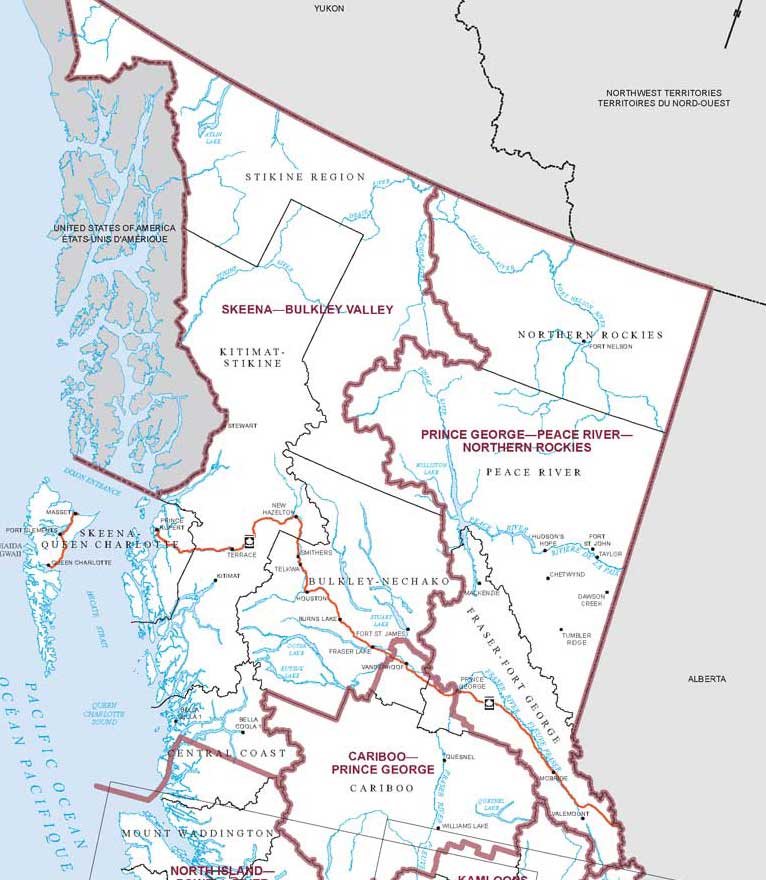
As for CBC, there are just eight radio staff, two in Prince Rupert and six in Prince George to cover all the apparently vital issues across half the province. ( Almost all the staff work mostly for the Daybreak North morning show which dominates the regional rates but it looks like with the latest CBC cutbacks that at least one of those positions will be eliminated). CBC TV and Global cover the region from Vancouver.
At least the Vancouver based media make efforts to cover the north from time to time. The Alberta media, however, especially the Calgary Herald, is hopeless, and so biased against British Columbia and so dismissive of the issues here, that the coverage across Alberta is completely unreliable about 90 per cent of the time—it’s no wonder that the majority of Albertans have no understanding of British Columbia culture and issues.
Then there are the punditi, pontificating from their cubicles in Ottawa and Toronto without a clue, without doing the basic journalism of picking up the phone (or writing an e-mail) to actually find out what’s going on.
Andrew Coyne, for example, made these rather silly two tongue-in-cheek tweets Thursday night. While Coyne’s tweets do often exhibit a sense of humour, his excellent coverage of the decline of our democratic parliament has to be compared with his blind, unchecked ideological assumptions about the issues of the northwest, which are simplistic, cubicle bound and far off the mark. The same can be said for Jeffrey Simpson in his occasional writing about this region. Neither the view from the Hill, where you can see as far as the Queensway, nor from Bloor Street, where you can see part of the Don Valley, are vantage points to understand what is going in northern British Columbia.
Update: Rex Murphy, writing in the National Post, has now joined the fray, no longer making a secret of his absolute disbelief in climate change and support for Enbridge. However, if you read his column, it is scathing in its contempt for the working men and women of British Columbia who want sustainable environmentally safe resource projects. It appears that to Murphy the only people in this country who actually work for a living in Canada are in Alberta and Newfoundland and no where else. Kitimat has been an industrial town since it was founded in the 1950s, Kitimat rejoiced when former Mayor Joanne Monaghan succeeded in bringing a Timmys to Kitimat and the majority of Kitimat residents voted in the plebiscite against Enbridge. But, of course, all those facts are irrelevant to Murphy and the other conservative pundits who never come within a thousand kilometres of northwestern BC, who believe we can’t think for ourselves and are easily misled by American environmentalists. No wonder journalism is in a death spiral.
Error checks
So let’s look at the specific errors in the media coverage of the Tim Horton’s story.
Both Shawn McCarthy in the Globe and Mail and Kyle Bakyx on CBC.ca seem to accept without question that SumofUs, was the instigator of the petition. Like many issues in northwestern BC, the Lower Mainland or US based activist groups follow the lead of northwestern BC and jump on the bandwagon, not the other way around. Jason Kirby in MacLean’s says the boycott movement began a week ago. Here in Kitimat, it began within hours of the ads appearing in the local Timmys and was picked up on activist social media groups before the SumofUs petition site.
McCarthy repeats the conventional wisdom: “The Conservatives and oil industry supporters have been waging a public relations war with the environmental groups that oppose expansion of the oil sands and construction of new pipelines.”
When is the media ever going to learn that opposition to Enbridge is widespread across most of northern British Columbia, from First Nations to city and regional councils to a plurality of residents? When is the media going to drop the stock phrase “First Nations and environmentalists”? Does anyone remember the vote in Kitimat last April against the Northern Gateway project?
CBC.ca quotes Alan Middleton of York University “Enbridge, of course, is not just pipelines and oilsands; they are a whole range of products including heating people’s homes. Tims should have thought about that.” Again a mistake. I lived in Toronto for many years. A company called Consumers Gas supplied natural gas to homes until it was taken over by Enbridge, so Enbridge does heat the homes in Toronto. But what has that got to do with northwestern British Columbia? Why didn’t CBC.ca call the University of Northern British Columbia? Easier to call York (which by the way is where I got both my BA and MA)
McCarthy quotes Rempel as saying, “One has to wonder whether head office talked to their franchise owners in Alberta before making the decision. I imagine those calls are being made this afternoon – certainly there are a lot of people voicing their displeasure.”
The question that should have been asked whether or not Tim Hortons consulted their franchise owners in British Columbia before ordering them to play the ads. People here were “voicing their displeasure” from the moment the first Kitimatian walked into the local Timmys for an early morning coffee and had to stand in line while being told how wonderful Enbridge is.
Of course, if Albertans force Tim Hortons into reinstating the ads, that will only trigger a bigger boycott in British Columbia. As Maclean’s asks, “what were they thinking?”
Jason Kenney, flying in, flying out
As for Jason Kenney, who is quoted by the CBC as tweeting: “I’m proud to represent thousands of constituents who work for Enbridge & other CDN energy companies,” if Kenney aspires to be Prime Minister one day, he had better start thinking about representing more Canadians than just those employed by the energy industry—a mistake that his boss Stephen Harper keeps making.
Jason Kenney did visit Kitimat for a just a few hours in February 2014 for a tour of the Rio Tinto modernization project and an obligatory and brief meeting with the Haisla First Nation council. If Kenney had actually bothered to stick around a few more hours and talk to the community, everyone from the environmentalists to the industrial development advocates, he might not have been so quick on the trigger in the Twitter wars.
Not one of the major media who covered this story, not The Globe and Mail, not CBC.ca, not MacLean’s, no one else, once bothered to actually call or e-mail someone who lives along the Northern Gateway pipeline route in British Columbia, the area where the boycott movement actually began to ask about Enbridge’s track record in this region. The media still doesn’t get it. This morning’s stories are all about Alberta. As usual, my dear, the media doesn’t give a damn about northwestern British Columbia.
That is why the coverage of the Tim Hortons boycott is a double double failure of the Canadian media.
Where else the media is failing northwestern BC
Full disclosure. Since I took early retirement from CBC in 2010 and returned to Kitimat, I have worked as a freelancer for CBC radio and television, Global News, Canadian Press, The National Post, The Globe and Mail and other media.
However, largely due to budget cuts, freelance opportunities, not only for myself, but others across the region have dried up. The media seems to be concentrating more on the major urban areas where there is larger population base and at least more of the ever shrinking advertising dollar. I am now told more often than I was a couple of years ago that “we don’t have the budget.”
Now this isn’t just a freelancer who would like some more work (although it would be nice). If the media these days actually had environmental beats for reporters the boycott of Tim Hortons in northwest BC would have been flagged within a couple of days, not almost two and half weeks and later only when Alberta got hot under its oily collar.
So as well as the Tim Horton’s boycott here are two major ongoing stories from Kitimat that the media haven’t been covering.
100 day municipal strike
-Kitimat’s municipal workers, Unifor 2300, have been on strike since February 28. Three rounds of mediation have failed, the union has refused binding arbitration, the pool, gym and community meeting halls have been closed since February, the municipal parks and byways are now returning to the wilderness. Only essential services are being maintained (but residents still have to pay their property taxes by July 2, taxes that are skyrocketing due to increased assessments for home values based on LNG projects that haven’t started) By the time most people read this the strike will have been on for 100 days. There is no settlement in sight and both sides, despite a mediator ordered blackout, are fighting a press release war on social media. Can you imagine any other place that had a 100 day municipal workers strike with no coverage in the province’s main media outlets, whether newspaper or television? Local CBC radio has covered the strike, as has the local TV station CFTK. (Update: District of Kitimat says in a news release that the mediator has now approved the DoK news releases.)
Of course, in the bigger picture the media concentrates on business reporting. There haven’t been labour reporters for a generation.
Kitimat air shed hearings
-The environmental hearings on the Rio Tinto Alcan proposal to increase sulphur dioxide emissions in the Kitimat Terrace air shed, after two weeks in Victoria, where there was no media coverage, are now continuing in Kitimat, where again there is little media coverage. CFTK is covering the hearings; otherwise the main coverage comes from the activist group DeSmog, hardly a credible or unbiased source. I made the decision not to cover the hearings either. I can’t afford any longer to sit around for two weeks, unpaid, no matter how vital the hearings are to the community.
So if most Canadians were surprised that there was a boycott of the unofficial national symbol, Tim Hortons, it’s because of that double double media fail and as the media continues to decline, as budgets are cut, as “commodity news” disappears, expect more surprises in the future. Oh by the way Kitimat is vital to the national economy but we can cover it from a cubicle in Toronto.
Final disclosure: I am not a coffee drinker. When I go to Timmy’s I prefer a large steeped tea and an apple fritter.
Rio Tinto, Shell LNG on shopping spree in China: Financial Times
Britain’s Financial Times today chose two Kitimat related companies to highlight how western business is turning more and more to China.
Shell turns to Asian suppliers in US shale race (Registration/subscription required)
Royal Dutch Shell has said it will deploy more Chinese equipment at its struggling US shale business – becoming the latest natural resources company to try to reduce costs by switching to cheaper Asian suppliers.
Miners such as Rio Tinto and Antofagasta have already been encouraged by improvements in the reliability of Chinese machinery, which they say can now be integrated into their existing operations without compromising efficiency or safety standards….Shell’s move comes as oil and mining companies – which ramped up capital expenditure in recent years amid a huge commodities boom – are being pressed by shareholders to curb spending and improve returns….
Rio Tinto, the Anglo-Australian miner, has also been on a spending spree in China. The company, which is slashing its capital spending after disappointing investors with cost overruns, says it made close to $2bn-worth of equipment purchases in China last year, and around $1bn-worth in India.
Rio Tinto Alcan has said that much of the building materials and equipment for the Kitimat Modernization Project has come from China, often in huge modules which are then inserted into the new buildings as part of the aluminum smelter upgrades.
Cookie crumble on Enbridge ad is unintended April Fool’s oops
Oops. Take a web editor on the Financial Post, plus ad cookies that are aimed just at you and an April’s Fool joke and what do you get…a unintentional joke that goes past the noon deadline.
I saw a link on Facebook to the Financial Post’s wrap up of April Fool jokes April Fool’s Day 2014: Hey WestJet, there’s no such thing as metric time.
So I scroll down to get chuckle or three.
The way the Financial Post/National Post laid out the web page, you soon read about Distl, a Toronto developer putting a condo on the moon.
Next you see the subhead “Bye-bye beaver” and right underneath it, an ad for the controversial Enbridge Northern Gateway pipeline.
Is this a joke? I ask myself. Nope the ad is a legit Northern Gateway ad.
Keep scrolling down and you find Root’s April Fools joke about replacing its iconic beaver symbol with a loon. Roots called “April Fool” on its Facebook page, saying: “Admittedly, we were a little ‘loony’ this morning. The beaver is and always will be at the heart and soul of Roots Canada! (P.S. Happy April Fools!) JF”
Of course it’s all about tracking cookies the place the ads. Someone in Toronto, Montreal or Ottawa will likely see a different ad.
But given the controversial Northern Gateway pipeline which will cross streams where beavers live, it’s also all cookie crumble for Enbridge.
(On a serious note, inappropriate ads normally would never have appeared in the old days when a human actually checked page. These days it’s always an algorithm)
Oil spill dangers can linger for 40 years, report shows
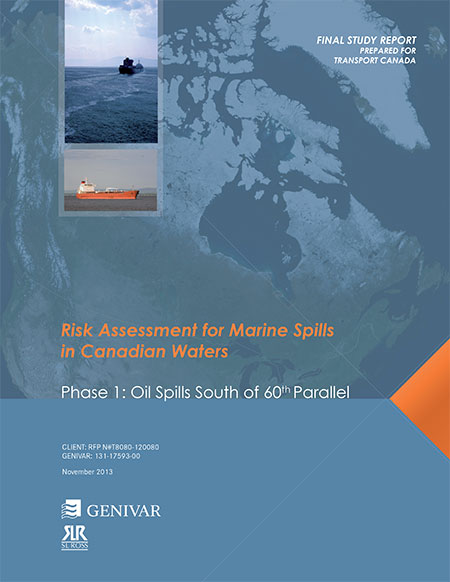
The Genivar report for Transport Canada on oil spills say that some persistent effects can last for more than 40 years, based on a study of a spill in Cape Cod, Massachusetts. The report notes that persistent sub-surface oil is still a problem at Prince William Sound, site of the Exxon Valdez disaster in 1989.
On long-term effects, Genivar reports: “The ingestion of contaminated food (such as oiled mussels), may represent the most important exposure pathway for aquatic fauna during a chronic
phase. Chronic exposure to contaminated sediments is also important for fauna or
vegetation.”
It goes on to stay that “large-scale oil spills might have considerable long-term
consequences on social structure and public health, interfering with traditions and
causing cultural disruptions.”
It appears that in the case of an oil-spill, time may heal some wounds, but not all of them, at least if time is considered within human lifetimes and the lifetimes of other species.
Ecological recovery is measured by how quickly individuals and populations of
species return to pre-spill conditions. It is determined by factors such as oil type,
exposure duration, water temperature, degree of weathering, spill response and the
individual and species-specific life history traits. In most environmental habitats,
recovery is completed within 2-10 years after a spill event, but in some exceptional
cases, such as in salt marshes, effects may be measurable for decades after the
event.In the case of the Exxon Valdez oil spill in Prince William Sound… in 1989, the persistence of sub-surface oil in sediments and its chronic exposure continues to affect some of the wildlife through delayed population reductions, indirect effects and trophic interactions 20 years beyond the acute phase of the spill.
It then goes on to stay that
Four decades after the oil spill In Wild Harbor (USA), Spartina alterniflora beds had a reduced stem density and biomass and mussels in oiled locations showed decreased growth and filtration rates.
According to a Boston Globe story, published at the time of the Deepwater Horizon oil leak in the Gulf of Mexico, in 2010, the Wild Harbor, an oil barge ran aground near Cape Cod in September, 1969, spilling 200,000 gallons of fuel, some of which is still there.
The Boston Globe story noted:
Today, Wild Harbor looks much like any other Cape Cod marsh, but the oil below the surface affects its resiliency. Fiddler crabs normally burrow deep down, funneling oxygen to the roots of marsh grass. Here, they stop digging when they reach the oil, turn sideways, and burrow back to the surface. They also act “drunk’’ from the oil they ingest, and predators can catch them more easily, research shows.
The Woods Hole Oceanographic Institute has been studying the Wild Harbor spill for the past 40 years.
At a recent conference, Dr. John Teal updated scientists on the “multi-decadal effects” of the Wild Harbor spill. According a blog on the conference:
At the time of the 1969 spill, lobsters, clams, and fish died by the thousands, but most people believed the harm would be temporary, reflecting the conventional wisdom of the time. Barge owners and oil industry experts even told residents that most of the oil would evaporate and any damage would only be short-lived. However, researchers at WHOI were not so sure and immediately began cataloging species and tracking where the oil was and kept at it for years. The researchers understood that the immediate, short term effects of oil pollution were already obvious and fairly well-understood, but that everyone was rather ignorant about the long-term and low-level effects of an oil spill….
Beginning three to five years after the spill, marsh grasses and marsh animals were again occupying most of the oiled area. An observer unfamiliar with Wild Harbor would not have been able to visually detect the oiled areas after just 10 years, and by the second decade after the spill, the marsh’s appearance had returned to normal. However, the WHOI researchers pointed out that for more than a decade after the spill, an oil sheen still appeared on the surface of the water when mud from the most heavily oiled parts of the marsh was disturbed….
In 2007, WHOI researchers documented that a substantial amount of moderately degraded petroleum still remained within the sediment and along eroding creek banks of the marsh oiled in 1969. They also demonstrated that the ribbed mussels that inhabit the oiled salt marsh, and are exposed to the oil, exhibited slower growth rates, shorter mean shell lengths, lower condition indices, and decreased filtration rates even when placed in a healthy marsh. Researchers have also documented detrimental effects of the 1969 oil spill on the salt marsh plants themselves.
Related Oil Spill on the Wild Harbor Marsh by John M. Teal and Kathryn A. Burns
The Genivar report goes on to note:
Long-term effects on the population in the aquatic environment (especially on mobile fauna) are especially difficult to confirm. Benthic [bottom dwelling] invertebrates may be more at risk than fish species due to the fact that more or less sessile organisms are likely to suffer higher initial rates of mortality and exhibit long recovery times as a result of
exposure to oil-saturated habitats.Nearshore demersal [bottom-dwelling] fish can also suffer from long-term chronic exposure, as indicated in masked greenlings and crescent gunnels by biomarkers on hydrocarbons 10 years after the Exxon Valdez spill. Mortality in sea ducks and sea turtles due to chronic exposure was also reported many years after the spill and other results indicate that effects on cetacean populations can last beyond 20 years after the acute exposure phase.
As for the recovery of the economy after a spill, Genivar notes it is based “on the time required for effected industries to be fully restored to pre-spill conditions.
The length of time required is influenced by the duration of the aquatic area closures (e.g. commercial fisheries, recreational fisheries), the public perceptions on seafood safety and the perceived effects of the aesthetic quality of the environment. Even after the full ecological recovery of the aquatic resources, fisheries can be far from reestablished, as is still the case for herring fisheries in the Exxon Valdez spill area…
As reviewed by Genivar, negative perceptions associated with the quality of fishery products, even for fisheries that have not been contaminated and also for regions not directly affected by the spill, can be far more important than the direct economic losses. This also holds true for the tourism sector and all other related spinoff sectors.
Why BC should watch the Australian election: LNG and natural gas are suddenly a top issue
Could the future of northwestern British Columbia’s hoped for natural gas boom depend on the outcome of this weekend’s Australian general election?
While the mainstream media in North America has mostly been following the personal feud between Prime Minister Kevin Rudd and Opposition Leader Tony Abbott or speculating whether or not Wikileaks founder Julian Assange’s party will make a ripple or a splish, a natural gas crisis has rocketed high on to the Australian election agenda.
I’ll be the first to admit that I know very little about Aussie politics, but I couldn’t ignore all the LNG and natural gas Australian election related stories that suddenly started showing up in my alerts.
LNG train “on ice”
This morning came the alert that Chevron has put the development of another train at its giant Gorgon LNG facility “on ice” (as a pun enabled headline writer in the Western Australian put it)
Chevron and its partners in the Gorgon LNG project on Barrow Island are expected to postpone work on detailed design and engineering of a fourth processing line at the mega project until at least next year as they battle to contain the soaring cost of the foundation development.
As reported by WestBusiness at the weekend, Chevron’s latest internal cost review is understood to have placed a final cost on Gorgon’s three-train venture of up to $US59 billion ($65.6 billion), or 13 per cent above the last confirmed budget revision of $US52 billion.
Chevron is refusing to discuss the status of the cost review and is understood to have told its Gorgon team to “value engineer” in the hope of substantially reducing the latest overrun on a project that was originally supposed to cost $US37 billion to complete.
Raw logs all over again
For a resident of northwestern BC, one thought comes to mind from the media reports on the LNG situation in the Australian election, it’s raw logs all over again.
It appears from those media reports that while Australia has huge reserves of shale-based natural gas, the way the country has structured its LNG boom, major industries and consumers are becoming alarmed that domestic natural gas prices for both will soon skyrocket. There are calls for whatever party wins the election to pass legislation that would create “domestic gas reservation” so that Australians won’t see the gas exported while they pay higher prices for what’s left over.
Most of the shale gas reserves are in Western Australia, while the population—and industry– are concentrated far away on the east coast.
That is leading to another controversy, demands that eastern Australia develop its coal gas reserves, which, of course, brings to mind Shell’s decision to forgo development of coal gas deposits in the Sacred Headwaters and the ongoing fight by the Tahltan First Nation to stop Fortune Minerals’ open pit coal mine in the Sacred Headwaters at Klappan.
Then there’s another vexing issue that northwestern BC is facing and soon have to deal with. In the election, some Australian politicians and unions are calling for curbs on the use for temporary (and not so temporary) foreign workers.
Another factor is the growing cost of natural gas extraction and LNG export, which has, in the midst of the election campaign, pitted Chevron against Australian unions, with Chevron executives (as they did in other contexts before the election call) pointing to Canada—that means Kitimat, folks — as the cheaper alternative.
Rising prices
The Australian has reported that a poll, commissioned by the nation’s manufacturers, so it is somewhat suspect, that:
Manufacturers will today claim that most Australians want a policy of domestic gas reservation and that this would sway voter intentions, a move set to renew the acrimonious debate over rising gas prices.
Manufacturing Australia will release a survey it commissioned where 35 per cent of people said it was “quite likely” and 13 per cent “extremely likely” that it would sway their decision at the election if a party made a policy pledge on the issue.Those uncertain stood at 21 per cent.
In one Australian riding, a local candidate wants one per cent of Australia’s gas be reserved just for the State of Queensland.
Bob Katter flew through Gladstone as fast as the wind whistled through Spinnaker Park on Monday, where he told local media he wanted to reserve a domestic gas supply for Australia and scrap the 457 visas that bring foreign workers into the country….
Mr Katter said mineral processing was under enormous pressure in Australia with copper processing wiped out in northern Queensland and to counter that, the Katter Australia Party would reserve 1% of the gas supply for Queensland.
“Because of the escalating skyrocketing cost of coal, gas and electricity in the past eight years, one per cent of the gas will be reserved for the benefit of the people in Queensland if not Australia,” he said.“That gas will be used to produce electricity at prices our retirees can afford, and young families can afford, and most importantly that our mineral processing plants have prices for processing they can afford.”
Coal gas
Another story in The Australian quotes James Baulderstone of the Australian energy company Santos:
THE NSW gas industry has warned of higher gas prices, job cuts and a significant risk to the state’s energy security if the coal-seam gas sector is not developed.
James Baulderstone, vice-president of eastern Australia at Santos, said without indigenous gas of its own, NSW had no ability to control its energy supply security.
“NSW faces prospective gas shortages as long-term contracts underpinning the state’s gas supply expire over the next two to three years, the very time in which the commencement of LNG exports from Queensland will see annual gas demand in eastern Australia triple,” he said.
“Looming natural gas shortages in NSW could be avoided by the timely and balanced development of the state’s already discovered reserves of natural gas.”
The Australian Liberal Party (which like BC’s is actually conservative) supports coal gas projects. But it also wants to force energy companies to develop gas reserves they have leased.
Chevron and the unions
Also embroiling the election is the growing dispute between Chevron and the Australian unions.
As the Australian Financial Review reported, Chevron is claiming that high costs are slowing the LNG projects and blaming the government of Prime Minister Kevin Rudd.
The federal government has rejected claims from Chevron that Australia’s high-cost economy is threatening the nation’s biggest energy project, Gorgon, even as the Maritime Union of Australia demands a 26 per cent pay rise and more than 100 other benefits for its members, including Qantas Club memberships and iTunes store credits.
As Chevron’s $52 billion Gorgon project became embroiled in the election campaign, trade union officials accused Chevron of seeking to dodge responsibility for poor labour productivity and high costs.
The union’s demands for employees working for 19 offshore oil and gas contractors around Australia include a 26 per cent raise over four years, no foreign labour without consultation, union control of hiring and four weeks holiday for every four weeks work.
(Note there are accusations of biased reporting during this election, especially from the media owned by Rupert Murdoch. I could find no independent confirmation of union demands for airline memberships and iTunes credits)
The Australian Labour minister, Gary Gray, who is from Western Australia, and according to reports, in a tough re-election fight, is blaming Chevron and the other energy companies for “failing to control the costs of their staff and contractors.”
“We do need our companies to get better in managing their productivity issues,” he said.
Prime Minister Kevin Rudd said he had studied China’s latest five-year economic plan and concluded Australia’s industrial relations system wasn’t hurting the industry.
Boom or bust?
The Australian Financial Review quotes Chevron Australia managing director Roy Krzywosinski as saying Australia has a two-year window to get policy settings right and fix industrial relations and productivity or risk losing out on billions of further investment in liquefied natural gas projects.
It goes on to make a reference to Shell and operations in Canada—again that’s Kitimat folks.
after the unprecedented rush of LNG investment in the past four years, Australia has become the most costly place worldwide for new plants, while new competition is emerging in North America and east Africa.
Shell, which has slowed its $20 billion-plus Arrow LNG project in Queensland, said construction costs in Australia are now up to 30 per cent higher than in the US and Canada.
Mr Krzywosinski said LNG projects are “long-term projects that transcend governments” and Chevron would work with all sides of politics to get policy settings right.
This Australian blogger warns:
The investment surge in LNG – often favourably compared with the Apollo moon program in its magnitude – is in some ways a bubble. Firms have rushed in, extrapolated an endless supply/demand imbalance for their product, ignored global competition, over-paid for assets and developed with little thought to what others were doing, grossly inflating input costs in the process.
The blogger goes on to say
This fallout is typical of the “built it and they will come” attitude that seized energy and mining executives in the final stages of the “commodity super cycle” boom. A similar story, with different dynamics, is playing out in coal and next year in iron ore.
The unions are largely not to blame for the cost blowouts even if they are a party to them. They are, after all, unions. What does capital think will happen if it hands them such a card to play?
Sound familiar?
Australia a mirror of the BC election?
Again it appears from this far off shore, that the Australian election is somewhat mirroring the recent BC provincial election and not only because of the issue of LNG. The Labour PM Kevin Rudd returned to power after three years on the back benches, coming back after the party dumped PM Julia Gillard.
Like BC, the Australian Liberal Party is really conservative. The Liberal Leader Tony Abbott, wants to abolish Australia’s carbon tax but Abbott is also threatening to fine companies that don’t lower prices if (or when) the carbon tax is abolished.
The polls show that the Liberal Party is leading, but that Kevin Rudd is more popular than Tony Abbott. Rudd is running an attack campaign against Abbott, warning of the consequences of an (conservative) Liberal victory. Sounds a bit like Christy Clark.
Given the split in the polls, with the leader of one party more popular than the leader of the party that is leading the polls, this video of the editors of The Australian which accompanies this story shows their senior editors are awfully confident, perhaps over confident, about the polls. I know given what happened in BC, Alberta and even Israel, I’d be a lot more skeptical.
We’ll know the outcome of the Australian election by this time next week. As for LNG, given the volatility of the market, who knows?
(Editor’s Note: Tony Abbott and the Australian Liberal Party won a landslide victory in the weekend vote)
(Note some of the Australian media sites appear to be metered and allow only one viewing)
Chevron postpones Kitimat LNG decision to 2014, seeks new equity partners, Dow Jones reports
The Dow Jones wire is reporting that Chevron has postponed a final investment decision on the Kitimat LNG project until 2014, “putting a deadline on a project that has already seen delays.”
Competitors are trying to sell natural gas to Asian customers using the cheaper Henry Hub North American market benchmark rather than higher Japanese bench mark which is based on the price of oil.
The Dow Jones report says Chevron, which is partnered with Apache, is still having problems finding customers in Asia. It quotes George Kirkland, head of Chevron’s upstream business, as saying that the company is offering customers equity stakes in the Kitimat project. Kirkland told a conference call that equity should be more attractive to buyers.
Kirkland said the company won’t approve the project until it has lined up customers for at least 60 per cent of Kitimat’s total 5 million metric tons a year of export capacity, although Kirkland expects that to happen in 2014.
“We’ve have had some discussions with Asian buyers,” Mr. Kirkland said during a call with investors. He declined to name the companies with which Chevron was negotiating. “It’s more likely to be a 2014 (decision), not late 2013,” he said.
U.S. natural gas prices were $3.37 per million British thermal units Friday, down from $13.69 in July 2008.
Chevron to Make Final Kitimat LNG Decision in 2014
Joe Oliver makes flying visit, meets Haisla, snubs Kitimat (almost)

Natural Resources Minister Joe Oliver made a brief visit to the Kitimat area on Tuesday July 23, 2013, meeting Haisla Chief Counsellor Ellis Ross. In the original planning for the visit, Oliver was not scheduled to meet with District of Kitimat Council or other members of the community, snubbing Kitimat in only his second visit to the region since he was appointed minister after the 2011 federal election.
A half hour meeting with available members of the District of Kitimat Council was squeezed in only after intense lobbying from Mayor Joanne Monaghan.
The Natural Resources department public relations staff also chose to ignore (or exclude) local media, with the exception of the Northern Sentinel. Northwest Coast Energy News, Kitimat Daily, CFTK and CRFN were not informed and did not accompany Oliver on his hour long tour of Douglas Channel.
After the meeting, Natural Resources Canada issued a news release saying that he had concluded “a successful visit to Kitimat,” hosted by the Haisla:
Minister Oliver discussed opportunities to increase First Nations’ participation in resource development and received a tour of the Douglas Channel hosted by Chief Councilor Ellis Ross.
“I am privileged to have been invited by the Haisla Nation to gain their perspective, listen to their concerns and discuss our plans for Responsible Resource Development and our initiatives to strengthen environmental protection,” said Minister Oliver. “Resource development presents a tremendous opportunity for First Nations groups like the Haisla. Our government has also been clear that development will only proceed if it is safe for the environment…”
“Responsible resource development has the potential to create significant new opportunities for Aboriginal peoples across Canada,” said Minister Oliver. “The Government will make every effort to ensure that…
Aboriginal peoples in Canada have the opportunity to share the benefits of energy resource development in the years ahead, while ensuring that projects are developed in a manner that has the highest regard for safety and the environment.”
“The safe and responsible diversification of our energy markets is a priority for the Government of Canada,” said Minister Oliver. “Our energy industry must remain competitive to ensure communities across Canada continue to benefit from our natural resource wealth.”
The Northern Sentinel reported that Oliver mainly concentrated on liquified natural gas development and tried to avoid questions about the Enbridge Northern Gateway project. Oliver repeated the federal government’s position on safety outlining the programs announced last march to expand pipeline expansion and increase penalties for safety violations.
On LNG, Oliver told the Sentinel, “These are decisions made by the private sector, it’s not us telling us don’t do this project…they’re going to figure that out themselves,” he said.
On the Enbridge Northern Gateway Pipelines Project, Oliver told the Sentinel, “We have a very strong interest in seeing the markets diversify, and that includes moving oil to Asia,” he said. “However, we’re not going to stomp over the regulatory process. It’s subject to regulatory review, the joint review panel will be coming to its conclusion this December. We’re waiting for what they have to say…I know people have a view of what our opinion is but we don’t offer an opinion before we hear from the regulator.”
He added that once the review is done, “At that point we’ll know more because they will have a done a comprehensive, scientific audit.”
Councillor Mary Murphy told Northwest Coast Energy News that she was told by a Haisla friend early Tuesday morning that Oliver was coming to visit Kitamaat Village and immediately informed Mayor Joanne Monaghan.
Monaghan said, “I called his office in Ottawa and said I wanted a meeting as well seeing he was here. After an all day back and forth until three o’clock he said he would come at four for half an hour.”
Councillor Corinne Scott said. “As none of us were aware of the Minister being in Kitimat, we scrambled to have Mary, Rob, the Mayor and I available to meet with him, along with [DOK Chief Admnistrative Officer] Ron [Poole] and [Economic Development Officer] Rose Klukas.”
Councillors Mario Feldhoff, Phil Germuth and Edward Empinado were unable to attend because they working at the time and could not get away with such short notice. Sources tell Northwest Coast Energy News that even pro-development members of the local business community were not informed about Oliver’s visit.
Murphy described the meeting “as very beneficial to us.” A couple of other sources, familiar with accounts of the meeting, however, both told Northwest Coast Energy News there was barely enough time after formalities to ask questions of the minister before he dashed out the door for the airport.
Oliver last visited the region in March, to make an announcement in Terrace. At that time he did not visit Kitimat.
Ellis Ross denies reports Haisla are softening position on Enbridge Northern Gateway
Ellis Ross, Chief Counsellor of the Haisla Nation tonight denied reports published in the Globe and Mail that the Haisla are softening their stand against the Enbridge Northern Gateway pipeline project.
Ross told Northwest Coast Energy News that the Haisla stand by their filings with the Northern Gateway Pipeline Joint Review Panel that the First Nation is opposed to the project that would build a pipeline to Kitimat to carry bitumen from Alberta and then ship to Asia by tanker.
Ross confirmed that the Haisla have withdrawn from its membership in Coastal First Nations, largely due to disagreements on liquified natural gas projects. The Haisla are a partner in the BC LNG project and have an agreement supporting the KM LNG project at Bish Cove which is in Haisla traditional territory.
In the Globe and Mail story Haisla First Nation withdraws from anti-Northern Gateway group, reporter Nathan Vanderklippe wrote:
The Haisla First Nation, an aboriginal group situated at the terminus on the B.C. coast of the proposed Northern Gateway pipeline, has pulled out of an organization that has stridently opposed the controversial project, and called for greener practices in the export of natural gas.
The Haisla said they have withdrawn from Coastal First Nations, effective immediately, amid a first nations debate about the environmental impact of West Coast industrial development that has now blown out into the open. The move also comes amid a softening Haisla stance toward oil exports from their traditional territory, which some see as evidence that the tide is turning on opposition to Gateway.
Ross strenuously denied that there has been any change in the Haisla opposition to the Northern Gateway project as the Globe and Mail is reporting. He says the disagreements with Coastal First Nations comes from the fact that the LNG project terminals are in Haisla traditional territory.
Another member of the Coastal First Nations, the Gitga’at First Nation at Hartley Bay told the Vancouver Sun it was worried about “huge volumes of pollutants could be pumped into the air associated with the development of a liquefied natural gas industry at Kitimat, affecting the health of the aboriginal community.” Gitga’at councillor Marven Robinson told the Sun that the First Nation is not opposed to LNG, but is questioning the risks and is seeking more information.
Ross said the Haisla Nation Council will likely issue a statement in the coming hours.
(more to come)
Apache delays Kitimat decision again, Wall Street Journal reports
The Wall Street Journal (subscription required) is reporting that Apache has once again delayed its decision whether or not to go ahead with the Kitimat LNG project.
So far there is no news release on the Apache site and no other media has matched the Wall Street Journal story.
Analysts are blaming the decision on the recent move by some players in the energy industry to sell natural gas to Asia at low North American prices, rather than the world price, which is determined as a percentage of the price of oil. A move by Asian countries to buy LNG at the lower North American market price would undercut the profitability of any LNG export project through Kitimat.

